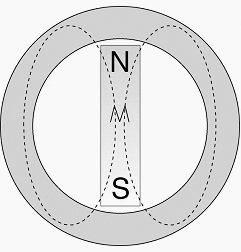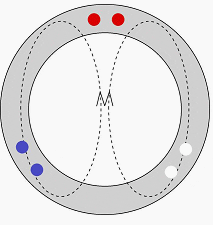What is the synchronisation?
To many people, the operation of a synchronous generator is very mysterious and strange. Here is this huge machine which runs are a constant speed whether the 4 – 24 inch steam valves are wide open or shut tightly the machine speed is constant.
Changing the steam flow into the machine changes the power output but has no effect on the speed.

Then there is the strange concept of reactive power. Reactive power flows are not supposed to be taking any energy and yet they change as the steam valves open and close.
Changing the excitation on the generator will change the voltage at the terminals but just a little. It has nowhere near the effect that changing the excitation would have on the machine when it is not synchronized or connected to the system. This technical article of the course will, hopefully, explain some of these phenomena.
The Magnetic Fields
One of the keys to understanding the strange behavior of the generator is develop a mental image of the magnetic field in the generator. Although there is only one magnetic field, for the most part we can consider it to be two; and a lot of the behavior of the machine can be explained by the interaction of the two magnetic fields.
For simplicity a two-pole generator is considered. The same arguments hold for generators with more poles however, the pictures and words to describe the interactions get more complicated.
The first magnetic field is the one set up in the rotor by the excitation system. It is field that is constant in strength and rotates around the machine at the speed of rotation of the rotor. The magnitude is directly proportional to the field current (as long as we do not saturate the magnetic circuit).

The second magnetic field is the one set up by the current flow in the three-phase stator winding. If a three-phase supply is connected to three windings displacedaround the core of the generator, the winding will generate a rotating magnetic field.
In a two-pole machine with a 60 Hz. Supply the speed of rotation will be 60 revolutions per second or 3600 rpm.

It is the interaction of these two magnetic fields that create the forces in the generator that transfer the energy to the electrical circuit.
The magnetic field from the stator current and the magnetic field of the rotor lock together and rotate at the same speed around and around in never ending circles. The magnetic fields do not line up perfectly unless the machine is producing no power output. There is an angle between them.
The angle is called the load angle or torque angle and it is related to the power output of the machine.
Forces between the Magnetic Fields
The force between the magnetic fields it the force between the shaft and the electrical system. It is this force that transmits the energy from the shaft to the electrical system.
When the fields are perfectly lined up with no angle between them there is no force and no power is transmitted. This is the no load state. The governor valves are open and allow just enough steam into the machine to overcome the frictional and windage losses of the unit turning at the synchronous speed. If the governor valves are opened more steam is admitted and the rotor starts to accelerate.
If more steam is admitted the angle increases (so does the sine of the angle) the force opposing rotation increases and the machine speed stays constant.

If the strengths of either magnetic filed is increased the power output of the machine remains constant but the increased forces between the fields pulls the rotor back towards its no load position and the load angle decreases.
In the operation of an individual synchronized machine there are two things that can be altered the governor valve and the rotor field strength, both affect the load angle. Increasing the field strength decreases the load angle but the load stays the same.
Increasing the steam flow increases the load angle and the power output of the machine increases.
Motoring
If the steam valves are closed to allow less energy in than that required overcoming the friction losses the rotor will tend to slow down. The magnetic fields will go out of alignment and a force will be generated to pull the rotor in the direction ofrotation.
This condition is called motoring.
The machine is driven as a synchronous motor. Motoring is a condition that may or may not be allowed in a generator. Most large steam turbines in CANDU plants have the capability of motoring at least of a time period.
What are the limits?
There is a limit to this phenomenon. If the load angle of the machine reaches 90°it has reached its maximum power output for the strength of the magnetic fields. If the power input to the machine pushes the rotor past the 90°position the retarding forces on the shaft start to decrease not increase.
The rotor will start to accelerate. It will start to travel faster than the rotating magnetic field of the armature.
However, lets not forget the millions of Newtons force that the magnetic fields can produce. And the rotor takes an extra revolution it will undergo severe mechanical stresses as the horrendous magnet force put torques on the shaft first trying to brake the machine and then trying to accelerate it.
It should be noted here that the load angle is a measurement of the electrical angles. These are the same as mechanical angles only in a two-pole machine. In a four-pole machine the mechanical shift of the generator shaft is one half of the load angle.
In machines with even more poles the mechanical angles become smaller and smaller.
Synchronized Generator Equivalent Circuit

The first key to explaining the behavior of a synchronized generator is the idea of load angle; how it changes with field strength and how it changes with load. The second key is the simplified equivalent circuit.
If the excitation current is increased Eg will increase. The phase of Eg will be determined by the load angle. Increasing the load angle will advance the phase angle of Eg. The inductive reactance X represents the impedance of the windings on the machine. The resistance of the windings is small compared to the inductive reactance and can be ignored in a circuit designed to give one a feel for machine operation rather than a look into the minute detail.
The terminal voltage Vt is a voltage that is determined by the rest of the system. A single generator in a large system has little effect on the frequency and the voltage or the system. For our simple little generator it will be the voltage at the terminals of the machine.
A couple more important things to recall, the voltage drop across X (Vx) will lead the current by 90°and Vt and Vx will add to give Eg,so long as we remember that when we add AC stuff we have to use phasors.
Reference: Science and Reactor Fundamentals – Electrical CNSC Technical Training Group











Very useful conceptual explanation, Many thanks !
Which type of motoring action occurred during pole slip of generator ? Either it is synchronous moror or induction motor ? When impedance loci travel from right to left of blinder it is generating mode but when it is travelling from left to right of blinder it motoring action….. But which type of motoring action.. Either it is synchronous motor or induction motor ?
explain briefly with the help of clean circuit diagram, explain the working of brushless excitation system of synchronous motor
What happens to the rotor angle delta when we increase the load in alternator?
THIS synchronization is referred at the mechanic seepd of machine because the machine workh a constant speed from this fact it name syncrona machine ,the same speed fixed for the number of poles and the frequency of the electrical net …
Really interesting article. I brought back memories of my time at UMIST in the lab.
What I want to know now is how the synchronisation happens in the inverter connected to the solar panels on my roof.